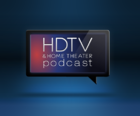 Feb 3
Feb 3 Podcast #777: Oppo UDP-203 4K Ultra HD Blu-ray Player Review
 Many of you (us included) have gone out and purchased a 4K TV sets but still have Blu-ray players connected to them. Sure these TVs do a good job at upconverting your 1080p content but we want more. We want native content at full bandwidth! There have been UHD players on the market for about a year that run about $300. Still many decided to wait. Some hoping for lower prices and others waiting for Oppo Digital to release their UHD player. If you were like us and waiting on the Oppo, your wait is over! The Oppo UDP-203 Ultra HD/Blu-ray player is available and it's only $549.
Many of you (us included) have gone out and purchased a 4K TV sets but still have Blu-ray players connected to them. Sure these TVs do a good job at upconverting your 1080p content but we want more. We want native content at full bandwidth! There have been UHD players on the market for about a year that run about $300. Still many decided to wait. Some hoping for lower prices and others waiting for Oppo Digital to release their UHD player. If you were like us and waiting on the Oppo, your wait is over! The Oppo UDP-203 Ultra HD/Blu-ray player is available and it's only $549.
| Download this Episode. |
Support the show with Patreon!
Listen to the show
Today's Show:
News:
- HBO Go now supports Apple’s TV app and single sign-on feature
- Connected TV Penetration Rises to 74% in Broadband Households
- 3D TV market wanes as HDR catches on
- DVD market dip weighs on Sony
- Fox Sports will broadcast Super Bowl 51 in a 'VR suite'
- Hulu, Amazon closing SVOD gap in customer satisfaction, but Netflix still on top
Other:
Amazon Prime:
Sign up for Amazon Prime and enjoy:
- Free Two Day Shipping!
- Instant Streaming of TV Shows and Movies
- Instant Access to thousands of Kindle Books
- The HT Guys gratitude!
Many of you (us included) have gone out and purchased a 4K TV sets but still have Blu-ray players connected to them. Sure these TVs do a good job at upconverting your 1080p content but we want more. We want native content at full bandwidth! There have been UHD players on the market for about a year that run about $300. Still many decided to wait. Some hoping for lower prices and others waiting for Oppo Digital to release their UHD player. If you were like us and waiting on the Oppo, your wait is over! The Oppo UDP-203 Ultra HD/Blu-ray player is available and it's only $549. We say only because it packs a lot of features in for that $549: Setup was easy! We pulled out the old Oppo player and put this one in it's place. We did have to swap out all but the Ethernet cable. The HDMI cable only needs to be swapped out if it's not certified as high speed. Since Oppo includes one in the box we just used the one that came with the player. Since our receiver is HDMI 2.0 and HDCP 2.2 certified we went through it. But if you have a situation where you don’t have a receiver that supports the latest standards you can use the HDMI 1.4 output on the Oppo to go to the receiver and use the HDMI 2.0 output to go to the TV. This will make it possible for a lot of people to enjoy high quality video and audio without having to buy a new receiver! For our testing we used two TVs. One that was 4K but did not support HDR and another one that did support 4K and HDR. The entire chain is described below: Oppo UDP203 ----> Yamaha RX-850A ---> Vizio 70 inch P-Series UHD TV Oppo UDP203 ---> LG 65UH6150 The Vizio was used for watching HDR content on TVs that don’t support HDR and the LG was used for the full experience. BTW, you can find the LG 65UH615A at Costco or Sam’s club for about $200 less than the 65UH6150 and from what we can tell they are identical in specs. After everything was connected we updated the firmware which took about 20 minutes. After that we were on our way. The menus are very basic but very functional. There are menus for Music, Photos, Movies, Network, Setup, and Favorites. The only menu we explored however is the network. We were somewhat surprised to see our Plex Server show up. It was a crude implementation but all our content was there. We were able to play some movies but the results weren’t very good,. The playback was choppy. This was with a hardwired connection as well. Since that wasn’t our main purpose of the review we got a few UHD discs and pushed forward. The Oppo allows you to tweak some video parameters. For our review we did not touch any of them. In fact the TVs were also left in their respective movie/cinema modes. We felt that this is how most people watch their TVs. If you have a professional calibrate your TVs you can expect even better results than what we experienced. Our evaluation was conducted with The Magnificent 7, Independence Day Resurgence, and Keeping up with the Jones. By the way, buy the UHD version of any movies you plan on watching in the future even if you don’t have a UHD player since they all have a Blu-ray option for purchase. First up was watching Blu-rays on the Vizio. For this we went back in our vault and pulled out Blackhawk Down. We were really looking at the night scenes and in particular the scene looking through the night scope. In these cases we were looking at how much detail was present. There would be no way to compare it against an HDR version but we were hoping that we would see more than the Blu-ray. And for this we were surprised. It did look better than the Blu-ray. The black levels were deep but not so deep that you couldn’t see detail. You could easily make out details in people’s faces and see the sweat and grime from a day of fighting. The night vision shot had clarity and a crispness that seemed to be enhanced by the player. The upconverter in the Oppo is very good. When examined up close we could not see any artifacts like in the old days of upconverting SD to HD. We wouldn’t say that it made the picture and more detailed or sharper, but it certainly didn’t make it worse. Then we watched Magnificent 7. For this movie the UDP-203 had to go from HDR to SDR on the Vizio. What we saw was very impressive. The movie was sharp and detailed. Colors were natural and warm. With that said, we didn’t find the improvement over the Blu-ray really compelling. We felt the same about Independence Day and Keeping Up with the Jones. The audio in all cases sounded like it was at another level. Whether it was Dolby or DTS the audio made the movie. We did experience a few lipsync issues while watching however. We hit pause and then play and it got better. We had to do that about 6 times over the course of five movies. We only experienced this on the Vizio and attribute the issue to the video processing. The LG has a newer processor and did not have this issue. The real test was going to be with a TV that supports HDR. For that, Ara took the UHD player to his condo where he setup his recently purchased LG 65UH6150. Full review of the TV in an upcoming show. There is no receiver in this setup. Braden was not able to view on the LG so the remainder of this section is written in the first person. First up was “Keeping up with the Joneses” Other than the noticeable improvement in detail there wasn’t much of an improvement. There were scenes where I could notice more realistic color and shadow details. This is a limitation of the disc not the player or the TV. Which brought us to a revelation. You really need to pay attention to your entire chain to get the most out of HDR. That includes the content. While I felt the Oppo did a great job with the movie, I was let down by the movie itself. But that’s OK I knew Magnificent 7 was going to be awesome! Next up was Independence day Resurgence. This was another disc that didn’t meet my expectations. There are a lot of dark scenes and HDR should have made a bigger difference. The shadow detail really didn’t look better than the Blu-ray. Again this is a limitation of the content. But that’s OK I knew Magnificent 7 was going to be awesome! I had high expectations for Magnificent 7. It looked really good on a non-HDR 4K TV after all. The Movie, TV and most importantly the UDP-203 did not disappoint! The detail and color were so lifelike it felt as though I was transported to the wild west. I found myself watching the detail at times and not the movie. It felt like I was being introduced to HDTV for the first time. Skin tones were the most natural I have ever seen. The beard/stubble on Chris Pratt’s face was so detailed I felt that he looked too groomed for the wild west. The detail in the dark scenes were more pronounced than on the Vizio. In fact the blacks seemed almost plasma like. The war paint on Red Harvest's face looked so good, again, it was almost too good! There were no visible artifacts that I could see even when I got up very close to the screen. This is why you want to upgrade your HDTV and Blu-ray player. If you have upgraded your HDTV to a UHD set that supports HDR you would be committing a crime if you didn’t upgrade your Blu-ray player. There are a few options out there and while the Oppo costs a little more you get so much more. The best audio playback support of any UHD player on the market today, coupled with ability upconvert to 4K video streamed over your local network or played through the USB and HDMI inputs makes the UDP-203 the most capable UHD player available at any price. Support for Dolby Vision via a firmware upgrade makes this player the only one on the market today that is future proof!Oppo UDP-203 4K Ultra HD Blu-ray Disc Player

Setup

Performance

Odds and Ends
Conclusion


Reader Comments (1)
Visio uses its Smart Interactivity feature to gathered data from more than 11 million smart TVs
This article was written by By Steven J. Vaughan-Nichols for Networking and posted on ZNET re: Visio using its Smart Interactivity feature, to gathered data from more than 11 million smart TVs. This Smart Interactivity "feature" worked by watching what you watch. It didn't matter where your content was coming from -- cable, streaming, DVD players, or over-the-air (OTA) broadcasts -- Vizio got it all.
Complete article below:
The Federal Trade Commission (FTC) announced on February 6 that Vizio had spied on almost every TV viewer from their Vizio smart TVs. Rather than fight the accusation any longer, Vizio has agreed to pay $2.2 million in fines and stop spying.
The spy in your smart TV.
Vizio has been spying for years on everything -- everything -- you watch on their smart TVs.
Vizio, with its Smart Interactivity feature, had gathered data from more than 11 million smart TVs. This Smart Interactivity "feature" worked by watching what you watch. It didn't matter where your content was coming from -- cable, streaming, DVD players, or over-the-air (OTA) broadcasts -- Vizio got it all.
The company reportedly did this by collecting a selection of on-screen pixels every second your TV was on, and then matched this to a database of TV, movie, and commercial content. This method of netting audio and video data is called automatic content recognition (ACR).
Vizio also recorded the date, time, channel of programs, and whether you watched the show live or recorded, the FTC said, and took all that data and connected it to your internet protocol (IP) address. With that much data, any big data analyst can know more about your television watching habits than your family does.
According to the FTC, "Vizio then turned that mountain of data into cash by selling consumers' viewing histories to advertisers and others". It added:
And let's be clear: We're not talking about summary information about national viewing trends. According to the complaint, Vizio got personal. The company provided consumers' IP addresses to data aggregators, who then matched the address with an individual consumer or household. Vizio's contracts with third parties prohibited the re-identification of consumers and households by name, but allowed a host of other personal details -- for example, sex, age, income, marital status, household size, education, and home ownership. And Vizio permitted these companies to track and target its consumers across devices.
If you looked very closely, you might know what Vizio was up to. Most people didn't have a clue.
FTC Acting Chairman Maureen K Ohlhausen added, "Television viewing activity is sensitive information." She continued:
We have long defined sensitive information to include financial information, health information, social security numbers, information about children, and precise geolocation information. We have also recommended that companies get opt-in consent before collecting and sharing the content of consumers' communications. But here, for the first time, the FTC has alleged in a complaint that individualized television viewing activity falls within the definition of sensitive information.
Vizio still claims "The ACR program never paired viewing data with personally identifiable information such as name or contact information." Instead, Vizio admits to "the use of viewing data in the 'aggregate' to create summary reports measuring viewing audiences or behaviors".
Still, "Vizio has agreed to stop unauthorized tracking, to prominently disclose its TV viewing collection practices, and to get consumers' express consent before collecting and sharing viewing information. In addition, the company must delete most of the data it collected and put a privacy program in place that evaluates Vizio's practices and its partners."
Still don't trust Vizio? You can turn Smart Interactivity, aka Video ACR, off by taking the following steps:
1. Press the MENU button on your TV's remote or open HDTV Settings app.
2. Select System.
3. Select Reset & Admin.
4. Highlight Smart Interactivity.
5. Press RIGHT arrow to change setting to Off.
In theory, this was disabled at the server-end on February 6. In practice, I'd still turn it off on my television too if I were you.
Vizio isn't the only company with an eye on your TV viewing habits. Samsung and LG have also had similar default settings that enable data collection.
To stop LG smart TVs in their data-gathering tracks, go to Options > LivePlus > Off. If you don't see LivePlus as a menu choice you're safe. On a Samsung, head to the TV's Smart Hub, and then: Terms & Policy > SyncPlus and Marketing > Disable.
Related Stories on ZNET:
How to keep your smart TV from spying on you
Online security 101: Tips for protecting your privacy from hackers and spies
Windows 10 privacy changes appease watchdogs, but still no data "off-switch"